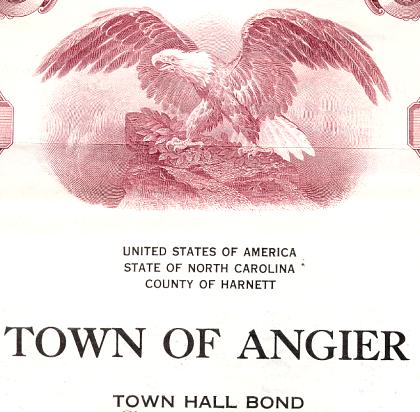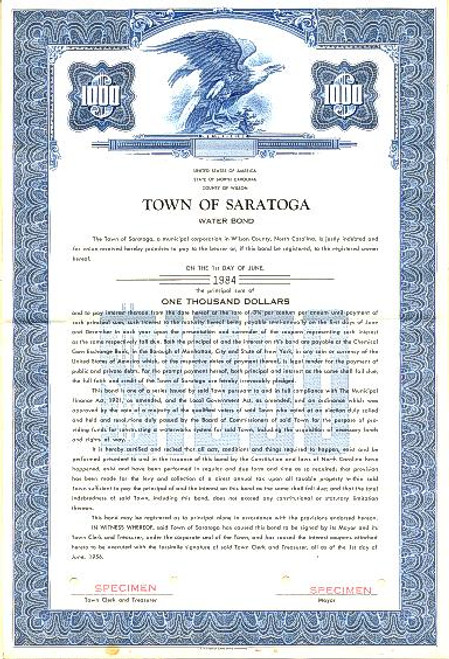Beautifully engraved Specimen certificate from the Town of Angier Town Hall Bond issued in 1956. This historic document was printed by Security Bank Note Company and has an ornate border around it with a vignette of an eagle. This item is hand over 49 years old. 
Certificate Vignette Angier, the Town of Crepe Myrtles, is a town of quietness, security and tremendous opportunity for its residents. Despite the substantial growth in this area, Angier is still the kind of town where you know your neighbors. J.C. Williams, who grew up in the area that is now Angier, is credited with being the "Father" of the town. "Jake" was one of the eight children of Jacob Williams, and often called Jake-of-all. His ancestry has been traced all the way 'pack to the sixteenth century to the Isle of Wales, Scotland. Jacob Calvin (Jake) married Nancy Norris of the Holly Springs section of Wake County and settled down to farm. He acquired a considerable amount of land. The first Harnett County Census in 1860 listed his holdings at 1300 acres. When the War Between the States broke out in April 1861, the Williams men put down plows and picked up guns to defend their homes. Jake served with Clingman's Brigade, Hokes Division, Company C, 3 1 st North Carolina Regiment. Records show that Jake was captured in 1864 and served time at Ft. Deleware. After his release, Jake returned home to rebuild his life. In 1872 he bought seven hundred and fifty acres of land for $3,000.00 from A.D. Cutts. The town of Angier is now located on some of that land. He and Nancy settled down on what is now North Broad Street. There they raised seven sons. It was Jake Williams' farm that the railroad, which put Angier on the map, was built in 1899. The railroad was little more than a tramway leading from Apex, in Wake County, to the Jake Williams' farm in Harnett County. It was first known and chartered as the Cape Fear and Northern Railroad; later, about 1906, the line was extended to Durham and the name changed to the Durham and Southern. The purpose of the railroad was to haul lumber and logs. The area around Angier had a vast sweep of fine saw timber, from short and long straw pines. The trees had been bled by the turpentine workers, leaving long stems of southern pine ready to be cut and sawed into lumber. When the turpentine business came to an end, workers and their families moved south to find un-bled timber; and a new era began. A new way of making a living and supporting a family began-saw milling. No longer was the ox cart and mule-drawn wagon efficient to move lumber and logs. Now the building of the railroad was hailed as a step forward. Farming was becoming more important; growing cotton and tobacco took the place of sawmill work as that era came to a close. The late Col. John C. Angier married the niece of the late Washington Duke whose "golden leaf' had found its way north after the war. The demand for more tobacco is said to have been the impetus for Mr. Duke and his sons to establish the American Tobacco Company. Col. Angier owned and operated a lumber plant in Cary and decided to build a railroad down along the pine ridge from Apex to Harnett County. Supposedly with the backing of the Dukes, he built a railroad to the farm of Jake Williams where a "Y" was also built for turning the engine around. In time, a station house was erected for the train crew to stay at night and daily round trips were made to Apex. Jake and his son Benton operated a general store and a turpentine distillery. Goods were transported to and from Raleigh or Dunn by two or four-horse wagons. The coming of the railroad was a boon to farmers, merchants and lumbermen. After much discussion and numerous suggestions, the station house was named Angier to honor Johnathan C. Angier who played a major part in bringing the railroad to the area. In July 1899, Jake Williams secured a noted surveyor, Daniel E. Green, to map and plot the land surrounding his home and the newly erected depot. Streets were laid off and named and Angier had its beginnings. By act of the North Carolina Legislature of 1901 the town received its charter. During the 1930's, The Angier Woman's Club undertook a project to have crepe myrtles planted on roadsides leading into town from all directions. The trees make a spectacular show during June, July and August. The town chose "The Town of the Crepe Myrtles" as its slogan. Every year a Crepe Myrtle Festival is held in September with food, crafts and entertainment for all. The Durham and Southern railroad which had run through the center of town since 1899, had its last run from Apex to Dunn on July 5, 1979. No longer was the railroad the cheapest way to transport goods to and from the industries of Angier and was no longer realizing a profit. Mayor Jack Marley and other town officials requested that railroad officials donate to the town the depot and the one hundred foot right of way within town limits. That was done and so ended another era. Today Angier is one of the fastest growing areas in Harnett County; it has been called the bedroom of the Research Triangle Park. Angier is located twenty miles south of Raleigh, nine miles north of Lillington, the Harnett County seat, and ten miles west of Interstate 40, on NC 210. History from Government Website.
About Specimen Certificates Specimen Certificates are actual certificates that have never been issued. They were usually kept by the printers in their permanent archives as their only example of a particular certificate. Sometimes you will see a hand stamp on the certificate that says "Do not remove from file". Specimens were also used to show prospective clients different types of certificate designs that were available. Specimen certificates are usually much scarcer than issued certificates. In fact, many times they are the only way to get a certificate for a particular company because the issued certificates were redeemed and destroyed. In a few instances, Specimen certificates were made for a company but were never used because a different design was chosen by the company. These certificates are normally stamped "Specimen" or they have small holes spelling the word specimen. Most of the time they don't have a serial number, or they have a serial number of 00000. This is an exciting sector of the hobby that has grown in popularity over the past several years.

Certificate Vignette
About Specimen Certificates Specimen Certificates are actual certificates that have never been issued. They were usually kept by the printers in their permanent archives as their only example of a particular certificate. Sometimes you will see a hand stamp on the certificate that says "Do not remove from file". Specimens were also used to show prospective clients different types of certificate designs that were available. Specimen certificates are usually much scarcer than issued certificates. In fact, many times they are the only way to get a certificate for a particular company because the issued certificates were redeemed and destroyed. In a few instances, Specimen certificates were made for a company but were never used because a different design was chosen by the company. These certificates are normally stamped "Specimen" or they have small holes spelling the word specimen. Most of the time they don't have a serial number, or they have a serial number of 00000. This is an exciting sector of the hobby that has grown in popularity over the past several years.








